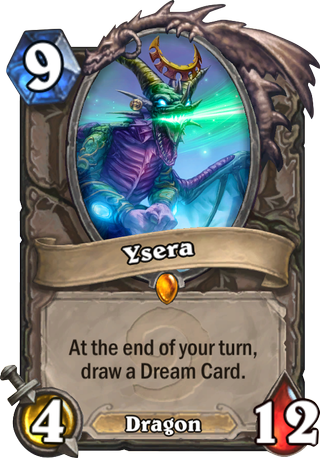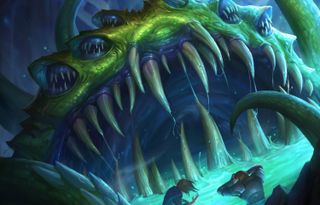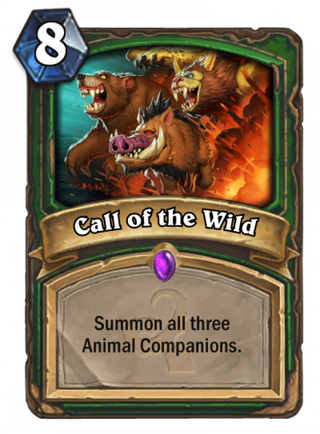What's wrong with competitive Hearthstone?
The finger of blame should be pointed at the variation between how cards generate value.

As with all successful online games, competitive Hearthstone is played against a backdrop of almost constant complaint from the community. Nonetheless, it’s hard to recall a time when both pro players and fans have been so vocal about what’s wrong. Another flashpoint came last week, with Na’Vi abandoning its successful team on the same day that Amaz’s exit from Team Archon effectively signaled the end of that organization.
The lack of prize money in tournaments, coupled with the fact that the top players seem to agree that the probability of success is too low even if they prepare perfectly, means that the scene faces serious questions over its viability. You know there’s an issue when the former world champion is trying to organize a tournament in which problem cards are banned.
As a viewer, I’ve certainly felt my desire to watch Hearthstone events diminish. That’s partly because as we improve, the knowledge gained from spectating becomes smaller, and there's also a degree of burnout from watching the same match-ups continuously. That said, I don’t think over-familiarity is the main problem facing competitive Hearthstone. After all, there’s always new content around the corner and another metagame to solve. The real issue is Blizzard’s design philosophy with regards to randomness and how cards generate value. But let’s be clear that thinking all RNG is bad misses the heart of the problem, which is important if we want to treat the cause rather than the symptom.
The real problem with RNG and card value
In my view, Hearthstone’s current issues stem from a small number of design decisions related to how certain cards generate value. Almost every new set includes a few such problematic cards, and it only takes a small number of them to negatively impact the whole game. Let’s look at specific examples of how Hearthstone cards generate value:
The good...

Ysera, Thoughtsteal, Mind Control Tech, and Quartermaster are more examples of good value generation. We’re looking for cards that either require you to pay additional Mana for the value they create, or need a condition to be met which your opponent can attempt to play around.
Cards that generate value randomly aren’t inherently bad, as evidenced by 1-Mana minions like Webspinner, Babbling Book, and Swashburgler—all of which have RNG effects, but haven’t come close to defining the metagame. These are good cards because they have relatively weak (though not irrelevant) bodies, so they can’t snowball a game. They also provide card draw, though not from your deck, which increases your options and enables you to change strategy. Crucially, none of these cards cheat their value into play, by which I mean you still have to pay Mana to use the random card you drew. So they feel “fair”. The randomness makes for exciting moments, alters the path of the game, and increases the amount of decision-making. These cards are strong enough to see play, but your opponent is unlikely to feel furious about their outcome.
It’s also important to consider how healthy value generation works on cards without random effects. Unearthed Raptor is a great example: if it manages to land on a good Deathrattle target, like a Twilight Summoner, it will generate insane value. The same can be said about cards like Defender of Argus, Goblin Blastmage, and Menagerie Warden. They all provide an injection of stats and tempo if played at the right time, but none have broken the game because they require a degree of setup. As a result, they allow for counterplay. If your opponent knows you might try to drop a Raptor or Warden, they can try to remove any good targets. Or take a risk that you don't have it, and go for a more aggressive line.

The bad...
Now let's consider some obvious offenders when it comes to random value generation. The reason cards like Tuskarr Totemic, Barnes, and Yogg-Saron are so frustrating is because of the range of value they offer—the difference between a free 1/1 and 3/4 totem is absurd!—and further compounded because they cheat the value into play.
The biggest gaming news, reviews and hardware deals
Keep up to date with the most important stories and the best deals, as picked by the PC Gamer team.
At this point, everyone has seen enough Yogg highlight reels not to require much extra explanation. It's a card that can win an otherwise lost game on the spot. These are cards which don’t present any additional choices for either player, or offer any effective counterplay beyond trying to end the game earlier. (The same was true of Nat Pagle and Tinkmaster, before they got nerfed.) Cards with large and unconditional effects ultimately aren’t compelling to watch or play—I don't think the players or the audience really feel the victory was earned when Yogg or Tuskarr swings a game.

Other examples of cards which either cheat random value into play or provide unconditional high value effects include Mad Scientist, Imp-losion, Knife Juggler, Dr.Boom, and Call of the Wild.
Again, not every example of bad value generation is RNG-based. One card that was hugely problematic in the past was Mysterious Challenger. The entire Secret Paladin deck was packed with value, but Challenger was nuts. For 6-mana it put a 6/6 on the board, and could play a 2/1 (sort of) taunt, plus another 2/1, plus another 3/2, and add 2 extra stats for any living minions on the next turn, and cast Hunter’s Mark on your opponent's creature. Even though this isn't precisely the right way to look at what the card did, we’re potentially talking about 25 points of stats, which effectively represents a Deathwing. People really hated it, and for good reason.
On the other hand people really like Reno Jackson, but I would argue he’s a similar problem card. There have been calls to make Reno an evergreen because some people see him as the solution to the aggro problem, but that would be a huge mistake when it comes to tackling Hearthstone's design issues. As with other problem cards, Reno generates a mountain of value. His effect is so strong that people are willing to compromise the quality of their entire deck in order to play him. What this means for matches involving Reno decks is that the game is often determined by the answer to one question: "Did I draw him?" Drawing a specific card is not a measure of skill and offers no counterplay.
It’s possible to argue that Reno and Mysterious Challenger are conditional effects, because you have to build the rest of your deck around them, but the condition activated too easily for it to be healthy.
On the next page: Proposed solutions
Most Popular

